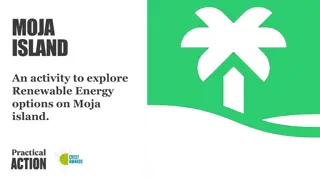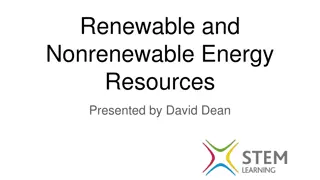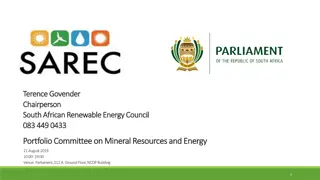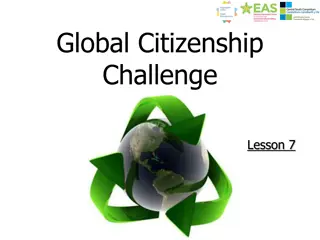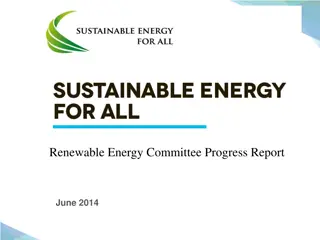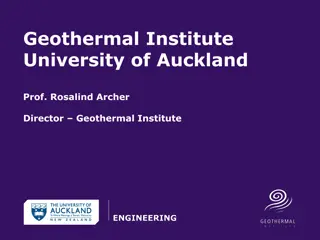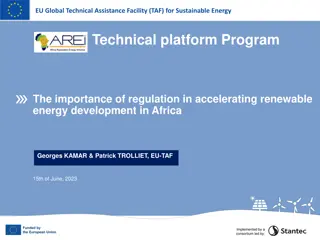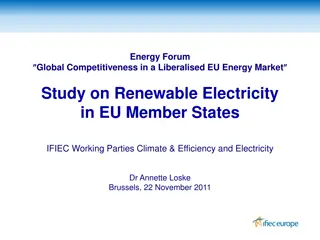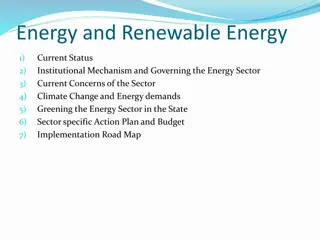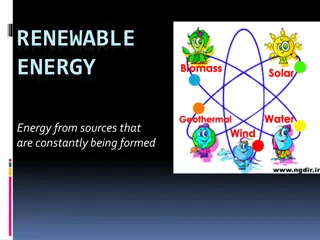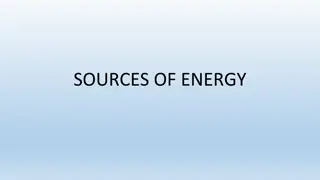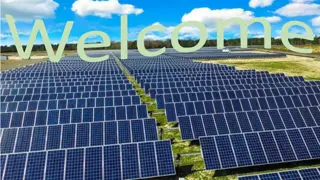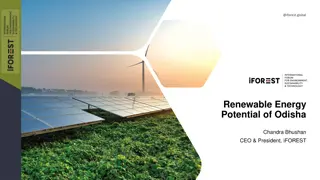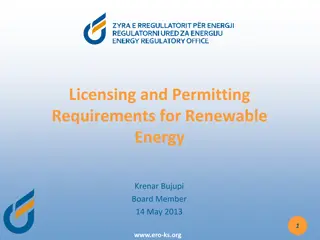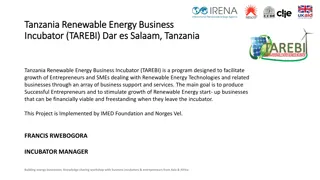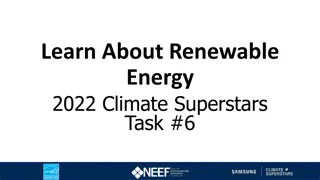Exploring Renewable Energy Sources in Portlaoise Workshop Overview
This workshop, designed for the JCT STE(A)M CPD workshop "Powering Your Sustainable Future," delves into renewable energy sources - wind, solar, and geothermal energies - in the Portlaoise area. Participants will analyze the social, economic, and environmental aspects of each energy source based on the available building materials and geological factors in the region. Considerations such as proximity to raw materials, recorded landslide and flooding events, and potential energy storage from granite bodies will be explored to empower informed decision-making for sustainable energy solutions.
Download Presentation

Please find below an Image/Link to download the presentation.
The content on the website is provided AS IS for your information and personal use only. It may not be sold, licensed, or shared on other websites without obtaining consent from the author. Download presentation by click this link. If you encounter any issues during the download, it is possible that the publisher has removed the file from their server.
E N D
Presentation Transcript
Handouts to be distributed for the Powering Your Sustainable Future workshop Complementary to and to be used with the Powering Your Sustainable Future PowerPoint presentation This workshop was created for the JCT STE(A)M CPD workshop Powering Your Sustainable Future
Things to consider about your chosen area: Portlaoise For this workshop, there are three renewable energy sources to consider: wind energy, solar energy, and geothermal energy. Each energy source requires a combination of building materials. You should consider which materials your area has access to when choosing your energy source. In your groups, you will consider either the social, the economic, or the environmental aspects of each energy source. What is there? - Limestone - Old Red Sandstone - Shales/sandstones/siltstone - Granite found ~40km away What does this mean? Can be used to make concrete Bedrock geology Granite bodies enhance heat potential Known lithium (metal) deposit in Leinster Granite; potential for energy storage Quaternary sediments * Generally glacial till * Some areas of peat * Small areas of alluvium - Numerous drumlins and eskers present Associated with some landslides in Slieve Bloom area Quaternary geomorphology Type of land Aggregates can be used as construction materials * Land is generally flat * Some mountains land around (Slieve Bloom Mountains ~30km away, Cullehnagh Mountain) - Multiple recorded landslides around Slieve Bloom Mountains - Four other recorded events in 25km radius from Portlaoise (Cullehnagh Mountain, Derrylea, Coltederry, and Maidenhead/Arless) Any recorded landslide events? Landslides need to be considered with wind turbine placement Any recorded flooding events? * Areas within a 30km radius of Portlaoise were affected by surface water flooding from the winter floods of 2015/2016 * Notably fewer areas affected by historic groundwater floods * According to Geological Survey Ireland Groundwater flood probability map, the area around Portlaoise is not at high, medium, or low probability risk. Proximity to any bodies of water? Proximity to raw materials such as metals? Not proximal to the sea, nor any major loughs or rivers - Proximal to Lisheen and Galmoy Mines (both now closed) which both mined lead, zinc, and silver - Proximal to Iapetus suture Irish-type mineral deposits (e.g. lead, zinc) are associated with this tectonic setting This workshop was created for the JCT STE(A)M CPD workshop Powering Your Sustainable Future
Energy Sources Wind Energy Solar Energy Geothermal Energy Image: Creative Commons Image: Creative Commons Image: Geological Survey Ireland Wind is inexhaustible and can be utilised to drive wind turbines. The motion of the blades drives an electric generator. The power from this generator can then be fed into the national grid. Though renewable, wind can be unreliable as it doesn t always blow. Therefore, backups to wind turbines are necessary for times when it isn t windy. Wind farms can be onshore or off-shore. Single turbines can be used to power a single house. In 2018, wind provided 85% of Ireland s renewable energy and 30% of our total electricity demand (SEAI). Often called photovoltaic cells, solar panels create energy when the sun shines on them. Special materials create electricity when exposed to light. This electricity can then be used to power cities, houses, and individual installations (road signs or parking meters). As with wind power, solar power can be unreliable. This is because the sun doesn t always shine. A backup energy source must be used when powering a grid with solar energy. Geo is Greek for Earth and thermal means heat; Geothermal energy is literally heat from the earth. Consistent source of energy, providing energy 24/7; however, it requires high initial capital costs. Ireland has good potential for geothermal energy, but the infrastructure is still lacking. However, policy is in development. There are two forms: shallow and deep. 1) Shallow geothermal used mainly for single buildings. Heat from the sun is trapped in the top layers of soil, rock, or water. 2) Deep geothermal used for district heating. Heat from the core of the Earth. Typically, the temperature increases 30 C with every 1 km of depth in a tectonically inactive area. To build a wind farm, you require metals and concrete. To build a solar farm, you require metals. To sink a geothermal well, you require metals and bedrock. This workshop was created for the JCT STE(A)M CPD workshop Powering Your Sustainable Future
Energy Sources extra information Carbon saved = A measure of how the technology can contribute to reducing our carbon footprint. This takes into account lifecycle emissions from: material uses, construction, transport and waste, etc. A higher number reflects a bigger saving compared to other technologies. Energy Density = A measure of how much electricity can be generated in a given volume. This takes into account: facility size, land required to mine materials and land required to dispose of waste, etc. High energy density is required for countries with high population densities like the UK. Sustainability = A measure of how long natural resources will last to fuel and build facilities. Some fuels have limited supply whereas others are completely renewable and depend only on the material requirements to build new facilities. Deployability = A measure of how developed and deployable a technology is. Some systems have been used on a large scale, others aren t commercially developed. Similarly, some technologies are commercially available but unlikely to be mass produced by private industry due to issues such as cost efficiency. Reliability = A measure of how consistent energy production is. Some systems are constant, others are predictably intermittent and others are unpredictable. This also takes into account the probability of breakdowns and the need for offline maintenance. Cost efficiency = A measure of the average cost of a unit of electricity over the lifetime of a facility. This takes into account buildings, operating costs, decommissioning and waste disposal. The higher the number, the more cost efficient (and therefore cheaper) a system is for producing electricity. Cards from https://documents.manchester.ac.uk/display.aspx?DocID=43217 This workshop was created for the JCT STE(A)M CPD workshop Powering Your Sustainable Future
Sources to get information from (Reliable) Sources Project Ireland 2040 National Planning Framework https://npf.ie/wp-content/uploads/Project-Ireland-2040-NPF.pdf Climate Action Plan 2019 https://www.gov.ie/pdf/?file=https://assets.gov.ie/25419/c97cdecddf8c49ab976e773d4e11e515.pdf#page=null Government of Ireland (www.gov.ie) info on policies, regulatory frameworks, roadmaps etc for renewable energy Geological Survey Ireland (www.gsi.ie) info on geothermal energy, maps to determine what is at your location, 3D model bedrock geology viewer, iCRAG (www.icrag-centre.org) info on geothermal energy, wind energy Sustainable Energy Authority of Ireland (SEAI) (www.seai.ie) info on solar energy, wind energy, ocean energy, bioenergy, Other resources to help with this workshop: http://documents.manchester.ac.uk/display.aspx?DocID=43217&_ga=2.45826788.1707102445.1607616277-283987030.1607616277m https://www.earthlearningidea.com/PDF/57_Power_thru_window.pdf This workshop was created for the JCT STE(A)M CPD workshop Powering Your Sustainable Future
Things to consider about your chosen area: What is there? What does this mean? Bedrock geology Quaternary sediments Quaternary geomorphology Type of land Any recorded landslide events? Any recorded flooding events? Proximity to any bodies of water? Proximity to raw materials such as metals? Other Find this information on Geological Survey Ireland s online map viewer (https://dcenr.maps.arcgis.com/apps/MapSeries/index.html?appid=a30af518e87a4c0ab2fbde2aaac3c228) and the other reliable sources. This workshop was created for the JCT STE(A)M CPD workshop Powering Your Sustainable Future







